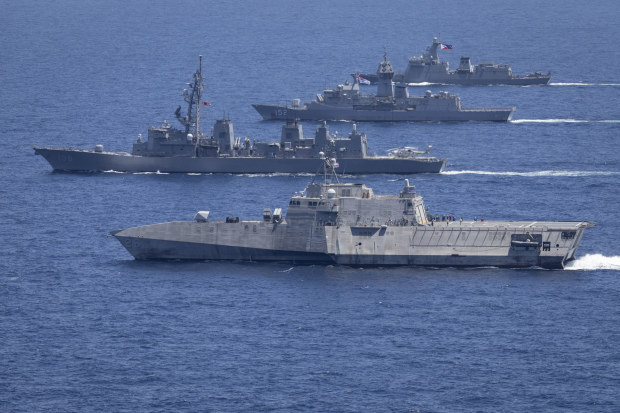China lashes joint war games involving Australia

China has lashed out at historic joint naval exercises involving Australian, Japanese, US and Philippines warships on the eve of confirmation Tokyo will be brought into the AUKUS fold.
Beijing responded to Sunday’s quadrilateral exercises inside the Philippines’ exclusive economic zone by conducting its own South China Sea naval and air combat war games.

USS Mobile, JS Akebono, HMAS Warramunga and BRP Antonio Luna during exercises between Australia, the United States, Japan and the Philippines off the coast within the Philippines Exclusive Economic Zone.
Quoting Chinese analysts, the state-run Global Times newspaper said the Chinese drill was a tit-for-tat response, “illustrating [the People’s Liberation Army’s] firm resolve and strong capability in safeguarding China’s territorial sovereignty and maritime rights and interests.
“It shows that China, while showing great restraint on the South China Sea issue, is also well-prepared to deal with any contingency,” the article said.
Chinese news agency Xinhua said the Philippines, supported by “external forces”, was fuelling tensions.
“It is imperative to recognise that any activities disrupting the South China Sea situation and creating buzzes will undermine regional peace and stability,” the Xinhua editorial said.
“The maritime disputes between China and the Philippines have heated up because the Philippines, backed by outside players, has been reversing its words and provoking China.”
Australia contributed the Anzac-class frigate HMAS Warramunga to Sunday’s drill, which a joint statement issued by the four countries said would “strengthen the interoperability of our defence/armed forces doctrines, tactics, techniques, and procedures”.
During a meeting of a delegation of Australian MPs with Taiwan’s outgoing President Tsai Ing-wen in Taipei on Monday, the deputy chairman of federal parliament’s intelligence committee, Andrew Wallace, referred to the joint exercises as he raised the sensitive topic of security co-operation, saying it was “paramount” between like-minded partners.
China has yet to respond to the prospect of Japan joining AUKUS, with Defence Minister Richard Marles and US and UK counterparts Lloyd Austin and Grant Shapps expected to issue a statement overnight formally opening talks with Tokyo to participate in the so-called Pillar II of the military technology sharing agreement.
Pillar II covers areas such as hypersonic missiles, undersea drones, electronic warfare and cyber activities. Japan will not join Pillar I, which underpins Australia’s acquisition of nuclear-powered submarines from the US and UK.
Assistant Defence Minister Matt Thistlethwaite said Pillar II was crucial for technological and cyber capability upgrades.
“So we want to make sure that we’re using the best technology available and using those partnerships with our alliance partners to uplift and improve Australia’s Pillar II capability,” he said.
Opposition Leader Peter Dutton welcomed Japan’s inclusion in AUKUS.
“The whole idea of the AUKUS agreement, when we negotiated that with the United States and the United Kingdom was that it could make us safer as a country in a very uncertain period,” said Mr Dutton, who was defence minister when AUKUS was announced in 2021.
“The work that’s been done around space, the work that’s been done in AI, all of that, Japan can contribute to significantly.”
With Beijing already opposed to AUKUS, Australian Strategic Policy Institute senior analyst Euan Graham said that “criticism from China [over Japanese membership] is very good prima facie evidence we are doing the right thing”.
But Dr Graham said America’s push for Japan to become part of AUKUS was also an indirect swipe at the slow pace of Australian decision-making over key parts of AUKUS, with the Albanese government putting off deliberations over an east coast submarine base and nuclear waste dump for years.
Subscribe to gift this article
Gift 5 articles to anyone you choose each month when you subscribe.
Subscribe nowAlready a subscriber?
Introducing your Newsfeed
Follow the topics, people and companies that matter to you.
Find out moreRead More
Latest In Federal
Fetching latest articles